Installation Ceremony
Friday, August 25, 2017
Ithaca, NY
Arts Quad
2 p.m.
Watch the ceremony on CornellCast
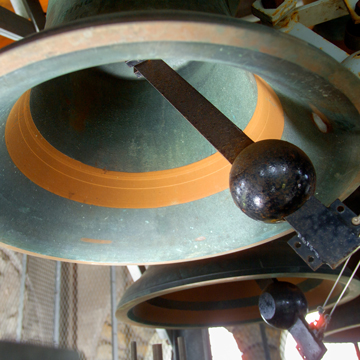
Prelude
The Cornell Chimes are the university's oldest musical tradition. Housed in historic McGraw Tower, the 21 bells are played primarily by student chimesmasters. Today's program features three songs selected by President Pollack:
- Brandenburg Concerto No. 2 (J.S. Bach)
- Promenade from Pictures at an Exhibition (Mussorgsky)
- Simple Gifts (Shaker Hymn)
The Cornell Chimes are the university's oldest musical tradition. Housed in historic McGraw Tower, the 21 bells are played primarily by student chimesmasters. Today's program features three songs selected by President Pollack:
- Brandenburg Concerto No. 2 (J.S. Bach)
- Promenade from Pictures at an Exhibition (Mussorgsky)
- Simple Gifts (Shaker Hymn)
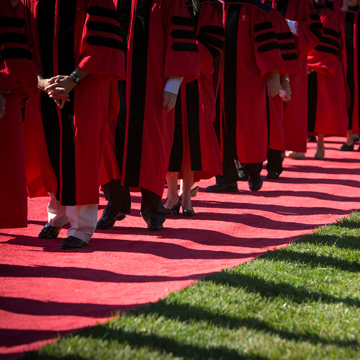
Processional
The procession lines up on Ho Plaza and makes its way onto the Arts Quad. The Cornell University Wind Symphony, directed by James Spinazzola, plays during the entire processional. The procession is made up of 87 delegates representing other universities, colleges, learned societies and institutions; over 300 individuals representing Cornell’s Assemblies, Reserve Officers’ Training Corps, faculty, academic professionals, librarians, staff and students; the university’s leaders and college deans; members of the Board of Trustees; and the platform party that includes ceremony speakers and bearers of the symbols of the university.
The procession lines up on Ho Plaza and makes its way onto the Arts Quad with music by the Cornell University Wind Symphony, directed by James Spinazzola.
The procession is made up of 86 delegates representing other universities, colleges, learned societies and institutions; over 300 individuals representing Cornell’s Assemblies, Reserve Officers’ Training Corps, faculty, academic professionals, librarians, staff and students; all the university’s leaders and College Deans; members of the Board of Trustees; and the platform party that includes ceremony speakers and bearers of the symbols of the university.
The Arts Quadrangle
The communal and historic heart of Cornell University’s Ithaca campus is the Arts Quadrangle, a tranquil green space bordered by venerable stone and brick buildings. It is the site of the university’s original campus, and a favorite gathering place for Cornellians. Students study, chat, or toss Frisbees on the lawn in the warmer months, and sculpt snow figures there between classes in the winter.
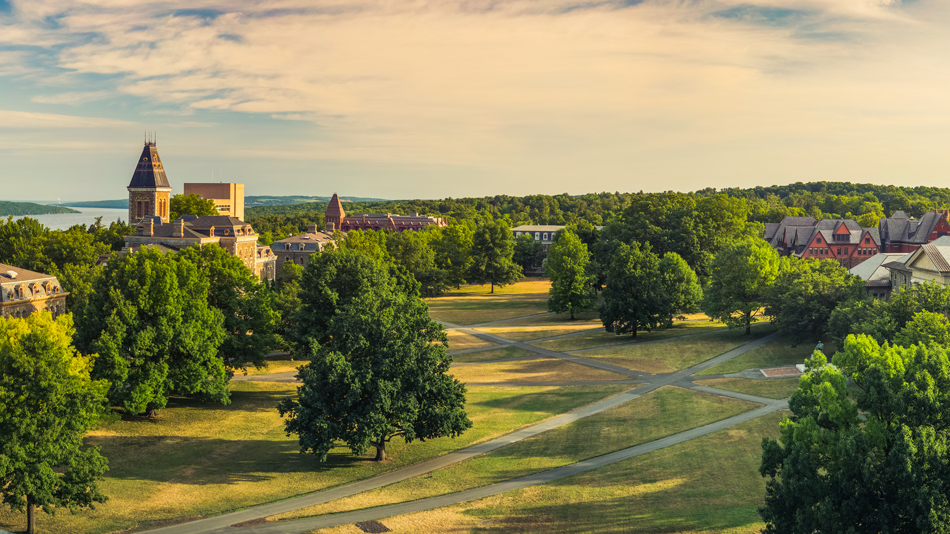
Founder Ezra Cornell is said to have stood on the future quadrangle’s northwestern corner when he announced his intention to build a university on this site. He and co-founder Andrew Dickson White, Cornell’s first president, visited many campuses, including those of Oxford, Harvard, and Yale, while planning the layout of the original quadrangle of the new university. White even sought the counsel of Frederick Law Olmsted, the designer of New York City’s Central Park. Succeeding generations of Cornellians have made only minor changes, preserving the Arts Quadrangle much as the founders planned it: a lovely, shady place for community activities, socializing, and reflection, on one of the most beautiful campuses in America.
The founders’ statues face each other across the quadrangle. White’s is on the east side, and Cornell’s on the west, in the middle of “Old Stone Row,” which consists of Morrill, McGraw, and White Halls. Morrill Hall, the first building constructed on the original campus, is a national historic landmark. Built of bluestone quarried from the land directly to the west of the quadrangle, which created the steep hill every Cornellian now knows as Libe Slope, these three earliest buildings still house a portion of the College of Arts and Sciences, as do Lincoln Hall and the massive Goldwin Smith Hall on the eastern side of the quadrangle.
The Herbert F. Johnson Museum of Art building, designed by renowned architect I. M. Pei, stands just off the northwestern corner of the quadrangle. Its neighbors, framing the quadrangle’s northern end, are Tjaden, Sibley, and Rand Halls, headquarters of the College of Architecture, Art, and Planning.
Uris Library, on the southwest corner of the Arts Quadrangle, incorporates Cornell’s most famous landmark, Jennie McGraw Tower, whose chimes and clock are part of daily campus life. Olin Library, one of the world’s great research libraries, anchors the southern boundary. On Cornell’s commencement day each May, the president, trustees, and guests gather on Olin’s terrace to view the degree candidates and faculty members as they assemble on the quadrangle and begin the march to Schoellkopf Stadium for the graduation ceremonies and celebrations.
Academic Regalia
Academic regalia in the United States generally conforms to an intercollegiate code established in 1895. The gown is commonly black, but may be designed with special variations to indicate the level of the wearer’s degree. The doctoral gown is paneled in velvet with three matching velvet bars on the sleeves that are black or a color associated by convention with the general field of the degree conferred; i.e., blue velvet is worn by a Doctor of Philosophy, purple by a Doctor of Law, and gray by a Doctor of Veterinary Medicine. Cornell University Trustees wear the doctoral gown. The University Marshal, the Bearer of the Mace, and Faculty Marshals wear ceremonial gowns of solid carnelian. Recipients of the Cornell doctorate may wear gowns of carnelian.
The tassel on the academic cap is black or the color associated with the degree field. Colors for Cornell degrees include agriculture and life sciences: maize; architecture: blue violet; arts and sciences: white; engineering: orange; fine arts: brown; hotel administration: dark red; human ecology: maroon; industrial and labor relations: orange yellow; law: purple; management: drab; medicine: green; and veterinary medicine: gray.
The hood bears a resemblance to the medieval cowl from which it derives. The Cornell hood has a distinctive lining of carnelian with two white chevrons.
Other institutional colors that are frequently seen at Cornell ceremonies include Brown’s brown, Chicago’s maroon, Columbia’s light blue with white chevron, Dartmouth's green with black velvet trim, Harvard’s crimson, Illinois’s dark blue with gold chevron, Michigan’s maize with azure chevron, Pennsylvania’s cardinal with blue chevron, Princeton’s orange with black chevron, and Yale’s dark blue.
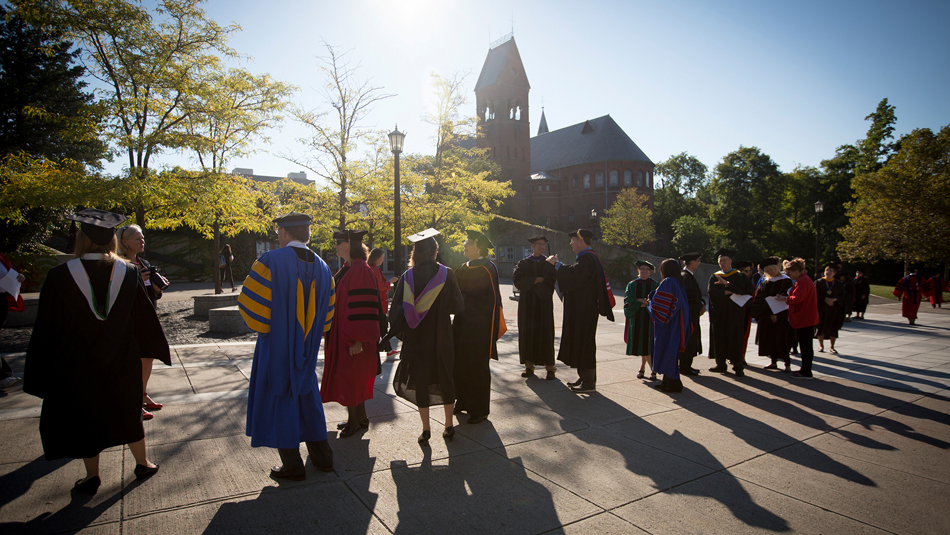
Order of March
University Marshal
Delegates Representing Other Universities, Colleges, Learned Societies and Scientific and Cultural Institutions
Representatives of the Student Assembly, the Graduate and Professional Student Assembly, the Employee Assembly, and the University Assembly
Commanders from the Reserve Officers’ Training Corps
Members of the University Faculty, Academic Professionals and University Librarians
The University Provost and the Provost for Medical Affairs
University Deans
University Administrators
The Chairman of the Board of Trustees
Members of the Board of Overseers
Members of the Board of Trustees
The Inauguration Speakers: Undergraduate Student Speaker, Jaylexia Clark; Graduate Student Speaker, Aravind Natarajan; Faculty Speaker, Charles Van Loan; and Staff Speaker Evelyn Ambriz
The Inaugural Poet, Ishion Hutchinson
The Bearer of the University Charter, Ezra Cornell, Trustee and Lineal Descendent of our Founder
The Bearer of the Seal of the University, Chad Coates, Employee-elected Trustee
The Mace Bearer, Mariana Wolfner, Faculty-elected Trustee
Past Presidents of Cornell University: Frank H.T. Rhodes, Hunter R. Rawlings III, Jeffrey S. Lehman and David J. Skorton
Special Guests of President Pollack: Mark Schlissel, President of the University of Michigan; David Munson, President of the Rochester Institute of Technology; and Phillip Hanlon, President of Dartmouth College
President Martha E. Pollack
Delegates
Harvard University
University of Pennsylvania
Princeton University
Columbia
Dartmouth
University of North Carolina at Chapel Hill
Williams College
Hamilton College
Union College
Hartwick College
State University of New York at Potsdam
University of Michigan
Centre College
University of Virginia
Norwich University
Colgate University
Indiana University
Amherst College
Hobart and William Smith College
Trinity College
State University of New York at Fredonia
University of Toronto
New York University
Oberlin College
Wheaton College, Massachusetts
The College at Brockport
Emory University
Alfred University
Mount Holyoke College
Boston University
Fordham University
University of Iowa
University of Rochester
Tufts University
Washington University in St. Louis
University of Florida
Elmira College
St. Lawrence University
Iowa State University
State University of New York at Oswego
Swarthmore College
University of Kansas
Carleton College
Roberts Wesleyan College
Wells College
Syracuse University
State University of New York at Geneseo
Vanderbilt University
Smith College
Wellesley College
Emerson College
Modern Language Association of America
Houghton College
American Historical Association
Georgia Institute of Technology
North Carolina State University
Pomona College
State University of New York at Oneonta
Barnard College
Keuka College
University of Chicago
Stanford University
University of California, Santa Barbara
Ithaca College
University of Tulsa
Clarkson University
Northeastern University
Skidmore College
Connecticut College
Rice University
Linguistic Society of America
University of Miami
Sarah Lawrence College
Tata Institute of Social Sciences
Siena College
Iona College
Helene Fuld College of Nursing
Binghamton University
Monroe Community College
Finger Lakes Community College
State University of New York Polytechnic Institute
Tompkins Cortland Community College
State University of New York Empire State College
Leadership of Cornell University
Senior Administration Officials
Martha E. Pollack
President
Michael I. Kotlikoff
Provost
Augustine M.K. Choi
Provost for Medical Affairs and Dean of Weill Cornell Medicine
Madelyn F. Wessel
University Counsel and Secretary of the Corporation
Joanne M. DeStefano
Executive Vice President and Chief Financial Officer
Gerald Hector
Vice President for Financial Affairs
David Lifka
Vice President for Information Technology and Chief Information Officer
Ryan T. Lombardi
Vice President for Student and Campus Life
Joel M. Malina
Vice President for University Relations
Kenneth M. Miranda
Chief Investment Officer
Glen C. Mueller
University Auditor
Mary G. Opperman
Vice President and Chief Human Resources Officer
James T. Kazda
Interim Vice President for Infrastructure, Properties and Planning
Paul Streeter
Vice President for Budget and Planning
Charles Van Loan
Dean of Faculty
Fred Van Sickle
Vice President for Alumni Affairs and Development
Academic Leadership
Glenn C. Altschuler
Dean of the School of Continuing Education and Summer Sessions
Gerald R. Beasley
Carl A. Kroch University Librarian
Kathryn J. Boor
Ronald P. Lynch Dean of the College of Agriculture and Life Sciences
Lance R. Collins
Joseph Silbert Dean of the College of Engineering
Soumitra Dutta
Dean of the Cornell SC Johnson College of Business
Kevin F. Hallock
Kenneth F. Kahn Dean of the School of Industrial and Labor Relations
Daniel P. Huttenlocher
Dean and Vice Provost of Cornell Tech
Kent Kleinman
Gale and Ira Drukier Dean of the College of Architecture, Art, and Planning
Barbara A. Knuth
Senior Vice Provost and Dean of the Graduate School
Gary Koretzky
Dean of the Weill Cornell Graduate School of Medical Sciences and Vice Dean at Weill Cornell Medicine
Alan D. Mathios
Rebecca Q. and James C. Morgan Dean of the College of Human Ecology
J. Gregory Morrisett
Dean of the Faculty of Computing and Information Science
Mark W. Nelson
Anne and Elmer Lindseth Dean of the Samuel Curtis Johnson Graduate School of Management
Eduardo M. Peñalver
Allan R. Tessler Dean of the Law School
Gretchen Ritter
Harold Tanner Dean of the College of Arts and Sciences
Kate M. Walsh
Dean of the School of Hotel Administration and E. M. Statler Professor of Hotel Administration
Lorin D. Warnick
Austin O. Hooey Dean of the College of Veterinary Medicine
Lynn Perry Wooten
David J. Nolan Dean of the Charles H. Dyson School of Applied Economics and Management
Office of the Provost
Judith A. Appleton
Vice Provost
Emmanuel P. Giannelis
Vice Provost for Research and Vice President for Technology Transfer, Intellectual Property and Research Policy
Daniel P. Huttenlocher
Dean and Vice Provost of Cornell Tech
Barbara A. Knuth
Senior Vice Provost and Dean of the Graduate School
John A. Siliciano
Deputy Provost
Laura M. Spitz
Vice Provost for International Affairs
Rebecca J. Stoltzfus
Vice Provost for Undergraduate Education
Office of the Provost for Medical Affairs
Gary Koretzky
Dean of the Weill Cornell Graduate School of Medical Sciences and Vice Dean at Weill Cornell Medicine
Javaid I. Sheikh
Dean of Weill Cornell Medical College in Qatar
Michael G. Stewart
Vice Dean and Senior Associate Dean for Clinical Affairs
Stephen M. Cohen
Executive Vice Provost for Administration and Finance
Daniel M. Knowles
Chief Medical Officer, Weill Cornell Physician Organization
Barbara Hempstead
Senior Associate Dean for Education
James R. Kahn
Deputy University Counsel and Secretary of the Medical College
Larry Schafer
Vice Provost for External Affairs
The Board of Trustees of Cornell University, 2017–18
Leadership of the Board
Robert S. Harrison, Chairman
David D. Croll, Vice Chairman
Barton J. Winokur, Esq., Vice Chairman
Jan Rock Zubrow, Chairman of the Executive Committee
Ex Officio Members
Andrew Cuomo, Governor (Deputy, Joshua J. Vlasto)
John Flanagan, President Pro Tem (Deputy, Jerry Bilinski)
Carl E. Heastie, Speaker (Deputy, Ronald T. Walsh)
Martha E. Pollack, President of Cornell University
Other Members of the Board
Sheila W. Allen
Richard A. Baker
Matthew L. Biben
Jessica M. Bibliowicz
Douglas L. Braunstein
David J. Breazzano
Dara Brown
John Ceriale
Mario Cilento
Chad O. Coates
David S. Cohen
Ezra Cornell
Gary S. Davis
Nicole Bisagni DelToro
David M. Einhorn
Elizabeth C. Everett Krisberg
Stephanie Keene Fox
Linda M. Gadsby
Thomas T. Groos
Alexander D. Hanson
Katrina E. James
Kraig H. Kayser
Ruben J. King-Shaw
Peggy J. Koenig
Robert S. Langer, Jr.
Bruce V. Lewenstein
Dustin Liu
Linda R. Macaulay
Pamela G. Marrone
Lowell C. McAdam
Ronald D. McCray
Mary John Miller
Howard P. Milstein
John A. Noble
Barbara Goldman Novick
Donald C. Opatrny
Leland C. Pillsbury
Jonathan K. Poe
Bruce S. Raynor
Girish V. Reddy
Gene Resnick, M.D.
Dale S. Rosenthal
George A. Scangos
Martin F. Scheinman, Esq.
Anne Meinig Smalling
J. Allen Smith
Dalia P. Stiller
Chiaki Tanuma
Ratan N. Tata
Michael A. Troy
Sheryl Hilliard Tucker
Laura A. Wilkinson
Mariana F. Wolfner
Craig Yunker
Jia Zhu
Karen P. Zimmer
Emeritus Chairmen
Peter C. Meinig
Harold Tanner
Emeritus Members
Robert H. Abrams
Ellen Gussman Adelson
Lilyan H. Affinito
John E. Alexander
Robert J. Appel
Stephen B. Ashley
Richard A. Aubrecht
C. Morton Bishop
Robert W. Bit
Robert T. Blakely, III
Kenneth H. Blanchard
Franci J. Blassberg
Richard L. Booth
Ann Schmeltz Bowers
James L. Broadhead
Dwight L. Bush, Sr.
Michael W. N. Chiu
J. Thomas Clark
Laura J. Clark
Abby Joseph Cohen
Paul F. Cole
Robert A. Cowie
Diana M. Daniels
Kenneth T. Derr
Ira Drukier
John S. Dyson
Robert R. Dyson
Anne Evans Estabrook
Fred Jacob Eydt
Mary C. Falvey
Miguel A. Ferrer
Stephen W. Fillo
David R. Fischell
Samuel C. Fleming
Cheryl A. Francis
Barbara B. Friedman
H. Laurance Fuller
James Lowell Gibbs, Jr.
Blanche Savin Goldenberg
Kenneth A. Goldman
Paul A. Gould
Patricia E. Harris
Myra Maloney Hart
Joseph H. Holland
Denis M. Hughes
H. Fisk Johnson
Thomas W. Jones
Albert J. Kaneb
Robert J. Katz
Karen Rupert Keating
Robert D. Kennedy
Harvey Kinzelberg
Benson P. Lee
Charles R. Lee
Jon A. Lindseth
Marcus H. Loo, M.D.
Carol Britton MacCorkle
Eli Manchester, Jr.
Thomas A. Mann
Dale Rogers Marshall
Kevin M. McGovern
Peter C. Meinig
Ronay A. Menschel
Robert W. Miller
Elizabeth D. Moore, Esq.
Rebecca Q. Morgan
Edwin H. Morgens
N. R. Narayana Murthy
John P. Neafsey
Carolyn Chauncey Neuman
Peter J. Nolan
Lubna Suliman Olayan
Armando J. Olivera
Margaret Osmer-McQuade
Roy H. Park, Jr.
Jeffrey P. Parker
Robert A. Paul
Andrew M. Paul
William D. Perez
William E. Phillips
Philip R. Reilly
Irene Blecker Rosenfeld
Jerold R. Ruderman, Esq.
Robert L. Ryan
Paul A. Salvatore, Esq.
William D. Sanders
Nelson Schaenen, Jr.
Robert W. Staley
Patricia Carry Stewart
Sherri Koenig Stuewer
Martin Y. Tang
Harold Tanner
Lisa M. Skeete Tatum
Peter G. Ten Eyck, II
Allan R. Tessler, Esq.
Samuel O. Thier
Andrew H. Tisch
Paul R. Tregurtha
M. Eileen McManus Walker
Sanford I. Weill
Roger J. Weiss, Esq.
Sheryl WuDunn
Philip M. Young
Michael J. Zak
David W. Zalaznick
The Board of Overseers of the Weill Cornell Medical College and Graduate School of Medical Sciences, 2017-18
Leadership of the Board
Jessica Bibliowicz, Chair
Robert Appel, Vice Chair
Robert A. Belfer, Vice Chair
Jeffrey Feil, Vice Chair
Barbara Friedman, Vice Chair
Sanford I. Weill, Chair Emeritus
Other Members of the Board
Tarek Abdel-Meguid
Hushang Ansary *
Madelyn Antoncic, Ph.D.
Ajay Banga
Ron Baron
H.H. Sheikha Moza Bint Nasser
Debra Black
Lloyd Blankfein
David S. Blumenthal, M.D.
Lewis C. Cantley, Ph.D.
Augustine M.K. Choi, M.D., Ex Officio
Chelsea V. Clinton
Abby Joseph Cohen
David M. Cohen
Alberto Cribiore
Caroline R. Curry
Ellen Davis
Robert S. Dow
Ira Drukier
Sanford B. Ehrenkranz
Israel A. Englander
Anne E. Estabrook
David R. Fischell, Ph.D.
Samuel Fleming *
Charlotte Ford
Harold Ford, Jr.
Kelli Olsen Ford
Kenneth Frazier
Richard M. Fuchs, M.D.
Antonio M. Gotto, Jr., M.D., D.Phil
Paul Gould
Jeffrey W. Greenberg
Maurice R. Greenberg
Leonard M. Harlan
Robert S. Harrison, Ex Officio
Alan Hartman
Raymond R. Herrmann, Jr. *
John Kanas
Evan H. Katz
Robert J. Katz
Harvey Kaylie
Michael M. Kellen
James M. Kilts
Harvey Klein, M.D. *
Gary Koretzky, M.D., Ph.D., Ex Officio
Charles R. Lee
Thomas H. Lee, M.D.
Arthur Mahon *
Raul Martinez-McFaline
Michael T. Masin
Peter C. Meinig
Ronay A. Menschel
Edward H. Meyer
Sandra R. Meyer
Howard P. Milstein
Edwin H. Morgens
Rupert Murdoch *
Stuart Mushlin, MD, Ex Officio
Spyros Niarchos
Timothy O'Neill
Margaret Osmer-McQuade *
Nancy C. Paduano
Nelson Peltz
Martha E. Pollack, Ex Officio
Stanley B. Prusiner, M.D.
Bruce Ratner
Philip R. Reilly, M.D., J.D.
Burton P. Resnick
Frank H.T. Rhodes *
David N. Roberts
Isadore Rosenfeld, M.D. *
Zev Rosenwaks, M.D.
Richard G. Ruben
Lewis A. Sanders
Herbert J. Siegel
A.J.C. Smith
Daisy M. Soros
Patricia Carry Stewart *
Nan Goldman Swid
Harold Tanner *
Samuel O. Thier, M.D.
Andrew H. Tisch
Igor Tulchinsky
Roger J. Weiss *
Carolyn S. Wiener
Barry Wolf
* Life Overseer
Cornell University Assemblies
Faculty Senate
Charles Van Loan, Dean of the University Faculty
Chris B. Schaffer, Associate Dean of the University Faculty
University Assembly
Gabriel Kaufman, Chair
Anna Waymack, Executive Vice Chair
Ulysses Smith, Employee Assembly Chair
Joseph Anderson
Edward Baptist
Matthew Battaglia
Linda Copman
Marie Anne de Roos
Kevin Fitch
Martin Hatch
Robert Howarth
Neeraj Jaisinghani
Jung Won Kim
Jeramy Kruser
Ellis Loew
Elena Michel
Katherine Quinn
Charles Van Loan
Ekarina Winarto
Employee Assembly
Ulysses Smith, Chair
Jeramy Kruser, Executive Vice Chair
Imani Allen
Peggy Ann Andersen
Babatunde Ayanfodun
Matthew Carcella
Atu Darko
Dustin Darnell
Christopher Dawson
Kevin Fitch
Tanya Grove
Laura Johnson-Kelly
Kristine Mahoney
Marjorie Mosereiff
Brandee Nicholson
Bruce Roebal
Carrie Sanzone
Tammy Shapiro
Kathy Sheils
Hurf Sheldon
Michelle Stefanski Seymour
Pilar Thompson
Shelly Vaccaro
Suzanne Willcox
Graduate and Professional Student Assembly
Ekarina Winarto, President
Manisha Munasinghe, Vice President
Kristen Angierski
Julia Bensur
Rachel Boylan
Arianna Gagnon
Jesse Goldberg
Rebecca Harrison
Jonathan Hernandez
Sarah Hesse
Margaret Jodlowski
Carol-Rose Little
Alex Loiben
Johnathan Maynard
Tyler McCann
Elena Michel
Margaret Milano
Dan Moon
Alexandra Schofield
Cassandra Stambuk
Nathaniel Stetson
Yadi Tang
Student Assembly
Jung Won, President
Varun Devatha, Executive Vice President
Thomas Ball
Dale Barbaria
Olivia Corn
Omar Din
Haris Hassan
Rebecca Herz
Matthew Indimine
Gabriel Kaufman
Lee Lipschutz
Tristan Magloire
Alec Martinez
Renee Morris
Sarah Park
Jesse Pollard
Samantha Romero Zavala
Jaelle Sanon
Christopher Schott
Evan Shapiro
Dara Tokunboh
Mayra Valadez
The Past Presidents of Cornell University
Past presidents Frank H. T. Rhodes, Hunter R. Rawlings III, Jeffrey Sean Lehman and David J. Skorton are participating in the inauguration ceremonies.

Elizabeth Garrett
2015 – 2016
Elizabeth Garrett, the university’s first woman president, was a dynamic leader who launched key initiatives before her untimely death.

David J. Skorton
2006 – 2015
A distinguished cardiologist and biomedical researcher, David J. Skorton enhanced Cornell’s strengths, not only in science and technology but also in the humanities, arts, and social sciences.

Jeffrey S. Lehman
2003 – 2005
The first alumnus to become president of Cornell, Jeffrey S. Lehman had been dean of the University of Michigan Law School.

Hunter R. Rawlings III
1995 – 2003
Hunter R. Rawlings III came to Cornell with a vision for organizing the remarkably diverse parts of the university to work more effectively together.

Frank H.T. Rhodes
1977 – 1995
During his 18-year presidency Frank H.T. Rhodes was a nationally recognized advocate for research and education.

Dale R. Corson
1969 – 1977
Dale R. Corson led the university through the final years of the Vietnam War and student activism, and through the economic recession of the 1970s.

James A. Perkins
1963 – 1969
Academic innovations were a hallmark of James A. Perkins’s administration.
Deane Waldo Malott
1951 – 1963
Deane Waldo Malott’s term as Cornell’s sixth president represents the largest period of building in the history of Cornell University.

Edmund Ezra Day
1937 – 1949
Edmund Ezra Day became Cornell’s fifth president in 1937 and later led the university through the turbulent years of World War II.

Livingston Farrand
1921 – 1937
A physician and public health advocate, Livingston Farrand presided over a period of growth but also the challenges of the Great Depression.

Jacob Gould Schurman
1892 – 1920
Jacob Gould Schurman came to Cornell as professor of Christian ethics and moral philosophy, and soon became head of the Susan Linn Sage School of Philosophy.

Charles Kendall Adams
1885 – 1892
Charles Kendall Adams, a former student of Andrew Dickson White’s, continued to build upon White’s legacy.

Andrew Dickson White
1865 – 1885
A radical idea in American education was born when Andrew Dickson White and Ezra Cornell crossed paths in the New York State Senate.
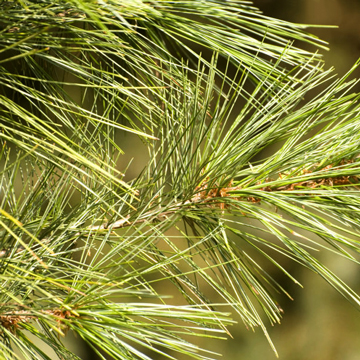
Words Before All Else
Sub Chief and Faith Keeper Karl Hill of the Cayuga Nation will deliver the "words before all else."
The "Ganǫhǫ́nyǫhk," translated as the "words before all else," is a traditional Haudenosaunee thanksgiving address. This is an ancient message of peace and appreciation of Mother Earth and all her inhabitants and is spoken before ceremonial and governmental gatherings.Sub Chief and Faith Keeper Karl Hill of the Cayuga Nation will deliver the "words before all else."
The "Ganǫhǫ́nyǫhk," translated as the "words before all else," is a traditional Haudenosaunee thanksgiving address. This is an ancient message of peace and appreciation of Mother Earth and all her inhabitants and is spoken before ceremonial and governmental gatherings.Haudenosaunee Thanksgiving Address, "Greetings to the Natural World"
The People
Today we have gathered and we see that the cycles of life continue. We have been given the duty to live in balance and harmony with each other and all living things. So now, we bring our minds together as one as we give greetings and thanks to each other as people.
Now our minds are one.
The Earth
Mother We are all thankful to our Mother, the Earth, for she gives us all that we need for life. She supports our feet as we walk about upon her. It gives us joy that she continues to care for us as she has from the beginning of time. To our mother, we send greetings and thanks.
Now our minds are one.
The Waters
We give thanks to all the waters of the world for quenching our thirst and providing us with strength. Water is life. We know its power in many forms‐ waterfalls and rain, mists and streams, rivers and oceans. With one mind, we send greetings and thanks to the spirit of Water. Now our minds are one.
The Fish
We turn our minds to the all the Fish life in the water. They were instructed to cleanse and purify the water. They also give themselves to us as food. We are grateful that we can still find pure water. So, we turn now to the Fish and send our greetings and thanks.
Now our minds are one.
The Plants
Now we turn toward the vast fields of Plant life. As far as the eye can see, the Plants grow, working many wonders. They sustain many life forms. With our minds gathered together, we give thanks and look forward to seeing Plant life for many generations to come.
Now our minds are one.
The Food Plants
With one mind, we turn to honor and thank all the Food Plants we harvest from the garden. Since the beginning of time, the grains, vegetables, beans and berries have helped the people survive. Many other living things draw strength from them too. We gather all the Plant Foods together as one and send them a greeting of thanks.
Now our minds are one.
The Medicine Herbs
Now we turn to all the Medicine herbs of the world. From the beginning they were instructed to take away sickness. They are always waiting and ready to heal us. We are happy there are still among us those special few who remember how to use these plants for healing. With one mind, we send greetings and thanks to the Medicines and to the keepers of the Medicines.
Now our minds are one.
The Animals
We gather our minds together to send greetings and thanks to all the Animal life in the world. They have many things to teach us as people. We are honored by them when they give up their lives so we may use their bodies as food for our people. We see them near our homes and in the deep forests. We are glad they are still here and we hope that it will always be so.
Now our minds are one
The Trees
We now turn our thoughts to the Trees. The Earth has many families of Trees who have their own instructions and uses. Some provide us with shelter and shade, others with fruit, beauty and other useful things. Many people of the world use a Tree as a symbol of peace and strength. With one mind, we greet and thank the Tree life.
Now our minds are one.
The Birds
We put our minds together as one and thank all the Birds who move and fly about over our heads. The Creator gave them beautiful songs. Each day they remind us to enjoy and appreciate life. The Eagle was chosen to be their leader. To all the Birds‐from the smallest to the largest‐we send our joyful greetings and thanks.
Now our minds are one.
The Four Winds
We are all thankful to the powers we know as the Four Winds. We hear their voices in the moving air as they refresh us and purify the air we breathe. They help us to bring the change of seasons. From the four directions they come, bringing us messages and giving us strength. With one mind, we send our greetings and thanks to the Four Winds.
Now our minds are one.
The Thunderers
Now we turn to the west where our grandfathers, the Thunder Beings, live. With lightning and thundering voices, they bring with them the water that renews life. We are thankful that they keep those evil things made by Okwiseres underground. We bring our minds together as one to send greetings and thanks to our Grandfathers, the Thunderers.
Now our minds are one.
The Sun
We now send greetings and thanks to our eldest Brother, the Sun. Each day without fail he travels the sky from east to west, bringing the light of a new day. He is the source of all the fires of life. With one mind, we send greetings and thanks to our Brother, the Sun.
Now our minds are one.
Grandmother Moon
We put our minds together to give thanks to our oldest Grandmother, the Moon, who lights the night‐time sky. She is the leader of woman all over the world, and she governs the movement of the ocean tides. By her changing face we measure time, and it is the Moon who watches over the arrival of children here on Earth. With one mind, we send greetings and thanks to our Grandmother, the Moon.
Now our minds are one.
The Stars
We give thanks to the Stars who are spread across the sky like jewelry. We see them in the night, helping the Moon to light the darkness and bringing dew to the gardens and growing things. When we travel at night, they guide us home. With our minds gathered together as one, we send greetings and thanks to the Stars.
Now our minds are one.
The Enlightened Teachers
We gather our minds to greet and thank the enlightened Teachers who have come to help throughout the ages. When we forget how to live in harmony, they remind us of the way we were instructed to live as people. With one mind, we send greetings and thanks to these caring teachers.
Now our minds are one.
The Creator
Now we turn our thoughts to the creator, or Great Spirit, and send greetings and thanks for all the gifts of Creation. Everything we need to live a good life is here on this Mother Earth. For all the love that is still around us, we gather our minds together as one and send our choicest words of greetings and thanks to the Creator.
Now our minds are one.
Closing Words
We have now arrived at the place where we end our words. Of all the things we have named, it was not our intention to leave anything out. If something was forgotten, we leave it to each individual to send such greetings and thanks in their own way.
Now our minds are one.
This English translation of the Mohawk version of the Haudenosaunee Thanksgiving Address was developed, published in 1993, and provided courtesy of: Six Nations Indian Museum and the Tracking Project. All rights reserved.
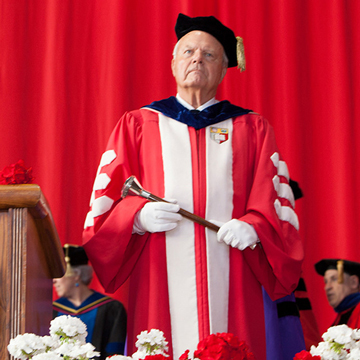
Convocation Call
University Marshal Charles Walcott, carrying the university baton, forms and directs the procession and calls the convocation to order. The baton is a rosewood shaft with a wrought-silver triangular knob bearing a rendering of the university arms and surrounded by a frieze of engraved ivy leaves.
Both the baton and the university mace were designed by Sir Eric Clements of the Goldsmiths’ Guild of London in 1962 at the request of President Deane Waldo Malott.
University Marshal Charles Walcott forms and directs the procession and calls the convocation to order.
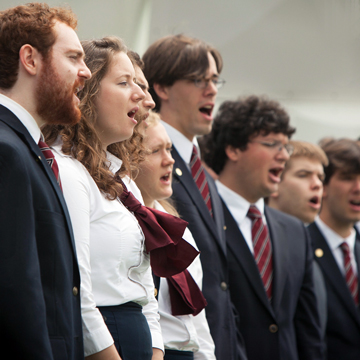
Musical Interlude
Cornell Chorus and Glee Club, directed by Robert Isaacs, perform "Strike up a Song to Cornell" by Richard H. Lee '41
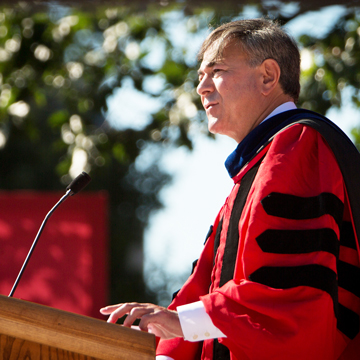
Inauguration Speakers
Cornell University’s Chairman of the Board of Trustees, Robert S. Harrison, will provide introductory remarks. He is followed by the inauguration speakers who will recite excerpts from four past Cornell presidents, each with strong ties to the University of Michigan. These readings are followed by remarks from Dartmouth College President Phillip Hanlon. The inaugural speeches conclude with a poetry reading by Ishion Hutchinson, Assistant Professor of English at Cornell University.
Cornell University’s Chairman of the Board of Trustees, Robert S. Harrison, will provide introductory remarks. He is followed by the inauguration speakers who will recite excerpts from four past Cornell presidents, each with strong ties to the University of Michigan. These readings are followed by remarks from Dartmouth College President Phillip Hanlon. The inaugural speeches conclude with a poetry reading by Ishion Hutchinson, Assistant Professor of English at Cornell University.
Welcome
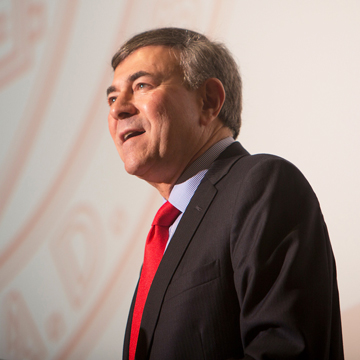
Robert S. Harrison
Chairman of the Board of Trustees
Robert S. Harrison led the Clinton Global Initiative as chief executive officer from 2007-16. Previously, he was an investment banking partner at Goldman Sachs and an attorney at Davis, Polk and Wardwell. A member of Cornell’s Board of Trustees since 2002, he became chairman in 2012.
Reflections on Cornell Inaugurations Past
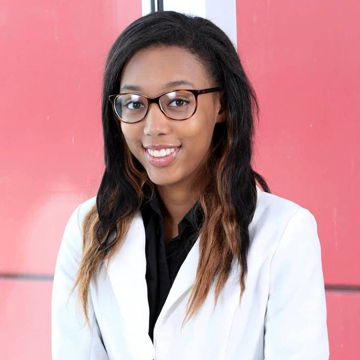 Undergraduate Speaker
Undergraduate Speaker
Jaylexia Clark
Industrial and Labor Relations '19
Excerpt from the inaugural address by Jeffrey S. Lehman, eleventh president of Cornell, on October 16, 2003:
[G]reat universities must continue to promote the spiritually satisfying coexistence of people with one another and with our planet. The dividing lines of race and religion have long been especially powerful stimuli for conflict, mistrust, segregation, and war. Scientific and technological progress have long challenged societal institutions to sustain humanistic and environmental values, even as they have enhanced the quality of human life. Universities have a special capacity to help students to be open to the challenges, to appreciate their complexity, and to engage them with all of the scientific, social scientific, and humanistic resources we can muster.
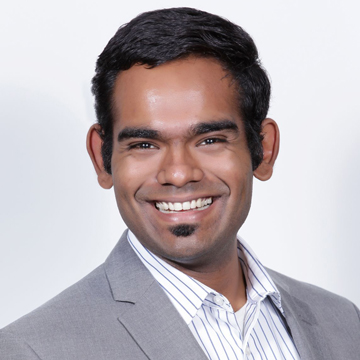 Graduate Student Speaker
Graduate Student Speaker
Aravind Natarajan
Doctoral candidate, Department of Microbiology
Excerpt from the inaugural address by Frank Rhodes, ninth president of Cornell, on November 10, 1977:
The research university is the great reservoir on which the fulfillment of all our hopes and larger society aspirations must draw. Knowledge is the base of the pyramid of progress. For all our problems — both local and global — are represented within the subjects that engage faculty members across the spectrum of Cornell’s schools and colleges. In confronting the towering technical and social challenges that these problems represent, there lies what hope of survival we have for the future. And in addressing the personal question of truth, meaning, justice, beauty, goodness, and hope, there lies the heart of those yearnings we have for survival with meaning and dignity. The research university is humankind’s best hope against the stark alternatives for the future.
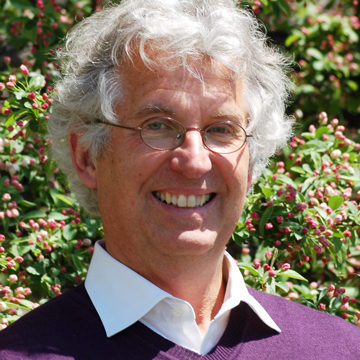 Faculty Speaker
Faculty Speaker
Charles Van Loan
Dean of the Faculty
Excerpt from the inaugural address by Edmund Ezra Day, fifth president of Cornell, on October 8, 1937:
On campuses such as this, thoughtful men and women, of faculty and student body alike, should be led to seek out all sorts of ideas: ideas that are deeply rooted in human experience; ideas that, like constellations in the intellectual firmament, have guided the earlier mariners of human thought; ideas that have more recently opened the doors of new knowledge of nature and of man; ideas that afford the foundation of our systems of law and order, of justice and liberty. Men and women on a campus like this should learn how knowledge is gained and wisdom won.
 Employee Speaker
Employee Speaker
Evelyn Ambriz
Assistant Dean of Students for Student Development Diversity Initiatives
Excerpt from the inaugural address by Charles Kendall Adams, second president of Cornell, on November 19, 1885:
It must never be forgotten that the possibilities of the greatest successes always carry with them the possibilities of feebleness and failure. The one is always the counterpart of the other. It is quite possible that there is more of crime and more waste of energy in a land of freedom, than in a land of oppression. But of far greater importance is the other fact, that there is immeasurably more of devotion to the higher interests of self and society. Herein indeed lies the chief advantage of freedom. In the history of education, the very highest results have never been reached except under systems that have given the largest liberties of choice.
Remarks
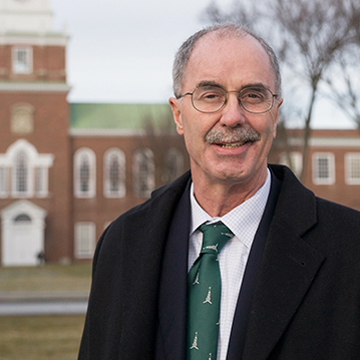
Philip J. Hanlon
President of Dartmouth College
Philip J. Hanlon became the 18th president of Dartmouth College on June 10, 2013. He is the 10th Dartmouth alumnus to serve as its president. As president, Hanlon has championed academic excellence and encouraged innovation in scholarship and teaching.
Poetry Reading
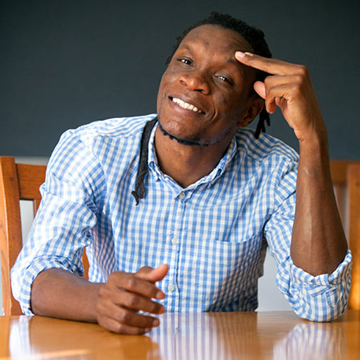
Ishion Hutchinson
Assistant Professor of English
Born in Jamaica, Ishion Hutchinson is the author of two poetry collections, Far District and House of Lords and Commons. He teaches in the graduate writing program at Cornell University and is a contributing editor to the literary journals The Common and Tongue: A Journal of Writing & Art.
Singing School Valediction
A scarlet breeze buoyed him next to us,
his white feather hair a boy’s, giddy and bright
for this, what he called, “the immaculate air.”
It never crossed my mind the wind could be fostered
down to such a casual vision, a taper of crocus
spied through a bubble level. Daily I have
climbed the mound to teach my seminars, some
days I dared look back, pushing the glass door,
at what was reflected in the glass; vermillion
shock of trees, a sky that swims blue and unbroken
with clouds, merging with those brindled hills,
some a wink of gold corona through power lines.
Always I disappeared inside before an eagle fell
from the sun, or whatever was subsequent to sun,
and charged the kids: recite. I listened, distanced.
But now, tuned to his big turnip face, fringed peat
moss sprouts from his ears, blackbird black brows
perked, flicker antennas, pulling from the air
words that filled our small, nervous compass
hearts with the love-harp light he twined between
us, I became a thicket of ears, tensed to engrave,
by instinct, the gradient shifts of his voice
before he scaled the promontory, a kingfisher
hushed back into the chrysalis he sang to us from.
Ishion Hutchinson

Investiture of the President
The official investiture ceremony is led by Chairman of the Board of Trustees, Robert S. Harrison. President Pollack is presented with the symbols of Cornell University: the University Charter, the Great Seal of the University and the University Mace.
The official investiture ceremony is led by Chairman of the Board of Trustees, Robert S. Harrison. President Pollack is presented with the symbols of Cornell University: the University Charter, the Great Seal of the University and the University Mace.
Symbols of the Office
The University Charter
As the land-grant university of New York State, Cornell University was chartered through an act of the New York State Legislature on April 27, 1865. The charter requires that the “several departments of study in the said university shall be open to applicants for admission thereto at the lowest rates of expense consistent with its welfare and efficiency, and without distinction as to rank, class, previous occupation or locality.” Moreover, “persons of every or no religious denomination shall be equally eligible to all offices and appointments.”
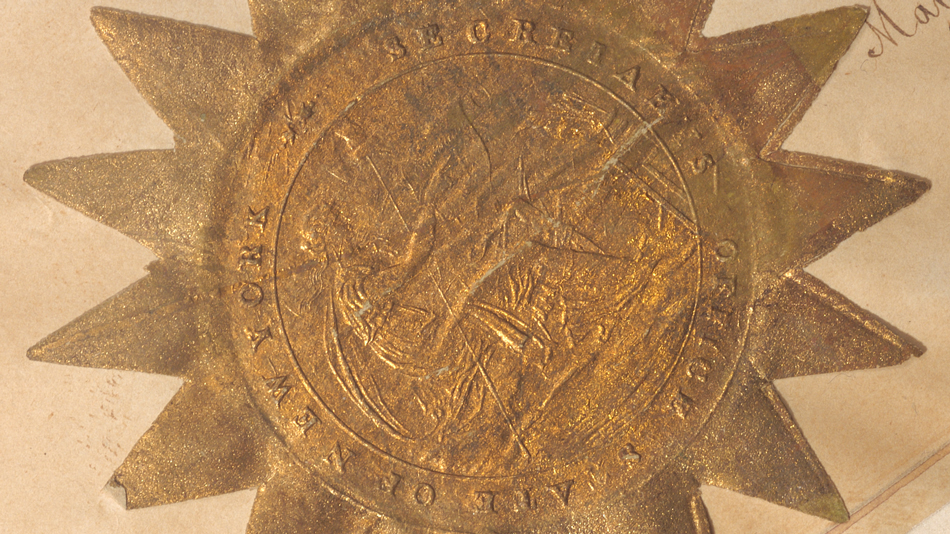
The charter defined Cornell University’s mission as: “...to teach such branches of learning as are related to agriculture and the mechanic arts, including military tactics, in order to promote the liberal and practical education of the industrial classes in the several pursuits and professions of life. But such other branches of science and knowledge may be embraced in the plan of instruction and investigation pertaining to the university as the trustees may deem useful and proper.”
Though the New York State Legislature has amended the charter from time to time over the course of the university’s history—to establish, for example, Cornell’s four New York State contract colleges—its essence has remained unchanged.
The original charter is presented to the president of Cornell University during the inaugural installation ceremony.
The Great Seal of Cornell University
On October 6, 1868 (the day before the university’s inauguration and that of its first president), the Cornell University board of trustees adopted the great seal of the university (also known as the presidential seal), creation of which it had originally authorized in November 1866. The great seal was first published in the Cornell University Register, 1868-1869. As described in the current version of the University’s Bylaws, the great seal is circular in form and two inches in diameter. The outer circle of the great seal bears the words "Cornell University" and "Founded A.D.1865"; the inner circle bears the name of university founder Ezra Cornell and his statement, “I would found an institution where any person can find instruction in any study.” A profile likeness of Ezra Cornell appears in the center of the great seal.
The great seal is the only symbol affixed to Cornell academic diplomas and its use is otherwise strictly limited. The custodian of the great seal is the university president. The board of trustees also adopted a corporate seal to be used for executing legal instruments or official University documents other than diplomas. Measuring one and one-half inches in diameter, the corporate seal is smaller than the great seal. Like the great seal, the outer circle of the corporate seal bears the words bears the words “Cornell University” and “Founded A.D.1865”. The center of the corporate seal contains the name of Ezra Cornell and, below his name, his profile likeness. The Secretary of the Corporation is the custodian of the corporate seal.
The University Mace
The Cornell mace symbolizes the authority of the university as exercised by its principal officers, especially the president. The mace consists of a tapered silver shaft surmounted by a golden terrestrial globe. The silver ribs surrounding the globe symbolize the universality of Cornell’s interests and the worldwide affiliations of its faculty, students, staff, and alumni.
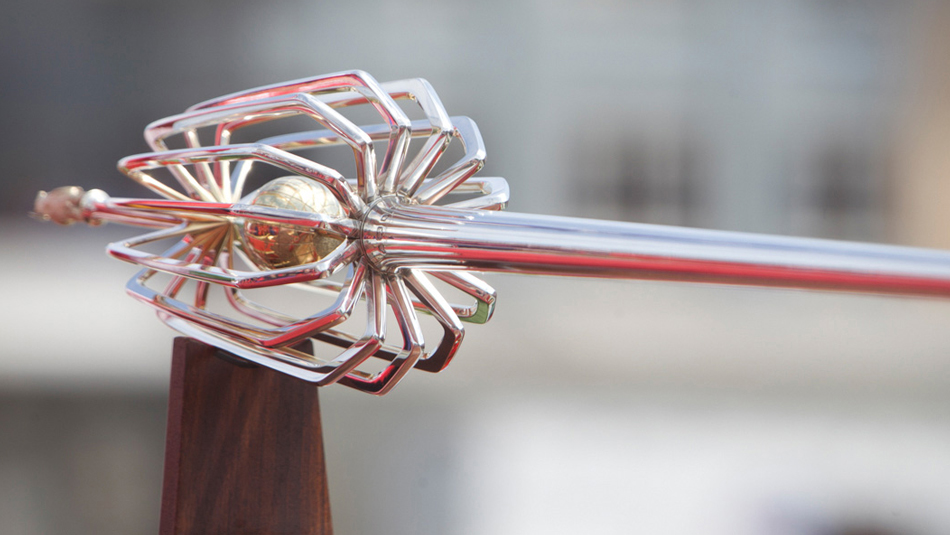
Both the mace and the university baton were designed by Sir Eric Clements of the Goldsmiths’ Guild of London in 1962 at the request of President Deane Waldo Malott, under the direction of George Healey, professor of English and curator of rare books, with the assistance of George J. Hucker, professor of bacteriology and chief of research at the university’s New York State Agricultural Experiment Station in Geneva, N.Y.
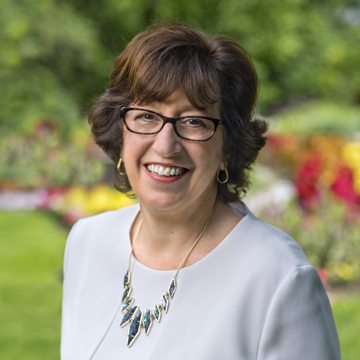
Inaugural Address
Placeholder
Placeholder
text
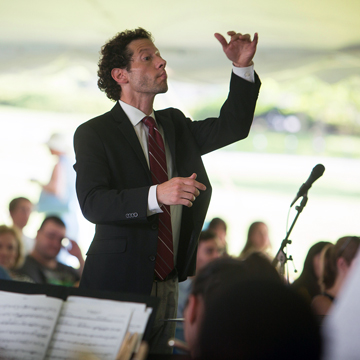
Recessional
The assembly will join the Cornell University Glee Club, Chorus and Wind Symphony in singing the Alma Mater. The platform party will recess to music performed by the Wind Symphony.
The assembly will join the Cornell University Glee Club, Chorus and Wind Symphony in singing the Alma Mater. The platform party will recess to music performed by the Wind Symphony.
Far Above Cayuga's Waters
Far above Cayuga’s waters,
With its waves of blue,
Stands our noble Alma Mater,
Glorious to view.
[Refrain] Lift the chorus,
Speed it onward,
Loud her praises tell;
Hail to thee, our Alma Mater!
Hail, all hail, Cornell!
Far above the busy humming
Of the bustling town,
Reared against the arch of heaven,
Looks she proudly down.
[Refrain] Lift the chorus,
Speed it onward,
Loud her praises tell;
Hail to thee, our Alma Mater!
Hail, all hail, Cornell!

